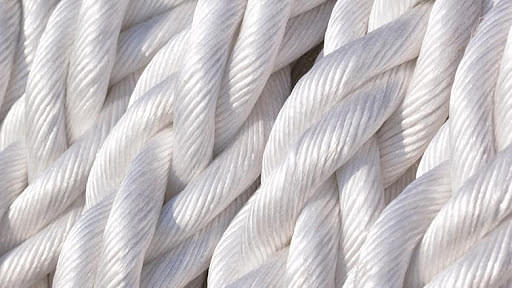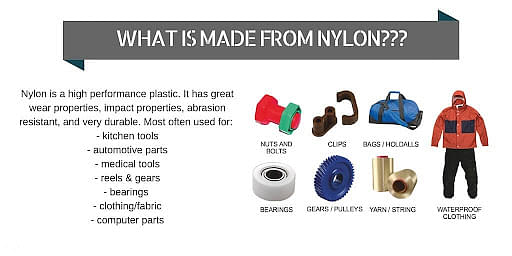
Content Curator
Nylon is the most useful synthetic material with operations varying from diurnal life conditioning to diligence. It's a plastic that can be drawn into fibers or molded into diurnal products for making amenities.
Wallace Carothers discovered nylon fabric in 1935. Nylon belongs to a group of synthetic polymers nominated as aliphatic polyamides or thermoplastics that are petroleum derivations. The discovery of nylon was driven by the necessity to replace weak natural fibers with commodities strong and durable like silk. Originally used for military purposes, the uses of nylon have diversified. Now it's the alternate most generally used fabric after cotton.
| Table of Content |
Read Also: Properties of Nylon
Preparation of Nylon
Nylons are condensation copolymers and are prepared by replying equal corridor of a dicarboxylic acid and a diamine. Nylon 6, 6, made up of monomer units hexamethylenediamine and adipic acid is the most common variant of this synthetic fiber. Each monomer is present alternatively in the copolymer forming the repeating unit and each contributing six-carbon titles to the polymer chain. The final nylon structure is the result of the following response.
The Science of Nylon
The term nylon points towards a polymer family known as direct polyamides. There are two approaches to making nylon for fiber operations. In the first approach, the motes that correspond to an acidic group (COOH) on every end reply with motes that contain amino (NH2) groups at each end. The performing nylon gets a name grounded on the number of carbon tittles that separate two amines and two acidic groups. Hence, nylon is extensively used as fibers made from adipic acid and hexamethylenediamine.
- The swab which is formed by two composites is known as nylon that has an exact rate of 11 acids to base. This swab is dried and also hotted under a vacuum to remove water and form the polymer.
- In the other approach, an emulsion that contains an amine at one end and acid at the other are polymerized to produce a chain with repeating units of (-NH- (CH2) n-CO-) x. The nylon is appertained to as nylon 6 if n = 5 which is another common form of this polymer. The marketable product of nylon 6 starts with caprolactam that use an open-ring polymerization.
- In both approaches, the polyamide is melted and drawn after cooling to gain the asked parcels of every intended use.

Properties of Nylon
- Lustrous
- Elastic
- Veritably strong
- Damage resistant to canvas and numerous chemicals
- Flexible
- Doesn't absorb water
- Dries snappily

Nylon
Types of Nylon
- Nylon 6 – It was developed by Paul Schlack. It's formed by ring-opening polymerization.
- Nylon 510 – It's attained from sebacic and pentamethylene diamine acid.
- Nylon – It's produced from dinitriles with the help of acid catalysis.
- Nylon 66 – Nylon 66 was patented by Wallace Carothers with the use of amide.
Uses of Nylon
- Clothing – Shirts, Foundation garments, lingerie, mackintoshes, undergarments, swimwear, and cycle wear.
- Industrial uses – Conveyer and seat belts, parachutes, airbags, nets and ropes, tarpaulins, thread, and canopies.
- It's used to make a bobbinet.
- It's used as plastic in the manufacturing machine corridor.

Uses of Nylon
Things to Remember
- Nylon is one of the essential fibers. You hop across the nylon carpet to the kitchen, eat your breakfast on a nylon coliseum after drawing your teeth with a toothbrush whose bristles are made of nylon.
- A nylon marquee over your head is used to move out of the house in heavy sun or to keep out of the rain.
- Wallace Carothers discovered Nylon in 1935. Indeed though it wasn't available for public use until after the Second World War, nylon was in expansive use among the service for canopies and parachutes. Polyester, still, came into actuality in the early 1940s and gained fashionability in the 1950s.
- Nylon belongs to a group of synthetic polymers nominated as aliphatic polyamides or thermoplastics that are petroleum derivations. The discovery of nylon was driven by the necessity to replace weak natural fibers with commodities strong and durable like silk. Originally used for military purposes, the uses of nylon have diversified. Now it's the alternate most generally used fabric after cotton.
Read Also: Properties of Polyamides
Sample Questions
Question. Nylon is generally used for what purpose?
Answer. To manufacture plastic machine corridor because it's cost-effective and long-lasting.
Question. Mention one advantage of Nylon.
Answer. It has high sequestration and resistance to erosion.
Question. How nylon is made?
Answer. Applicable monomers are combined to form a long chain through a process of the condensation polymerization response.
Question. How do Natural Fibres Differ from Synthetic Fibres?
Answer. The differences between natural and synthetic fibers are
- Source All types of natural fibers are carried from natural sources, but synthetic fibers are entirely mortal-made.
- Form The length of natural fibers can not be manipulated, and they come in hair or chief form. Synthetic fibers plant in hair form can be converted to the chief and spun into the asked length.
- Spinning Natural fibers don't bear spinning for a hair product. But spinning is demanded hair product in synthetic fibers.
- Yarn product While yarn product of natural fibers doesn't bear chemical results, synthetic yarns are produced by using results of chemicals.
- Chastity Natural fibers may harbor dust and contaminations. Synthetic fibers are free from contaminations.
- Continuity Natural fibers aren't as durable as synthetic fibers.
- Dyeing Natural fibers can be accessibly bepainted, but synthetic bones don't take up color fluently.
Question. What's the Difference Between Nylon and Polyester?
Answer. The following are the bases of differences between nylon and polyester
- Chemical nature While nylon is a polyamide, polyester is a polyethylene naphthalate.
- Manufacture Nylon is prepared as a liquid followed by mechanical spinning and drying into individual fibers. Polyester is made into vestments from chemical results.
- Wearability Nylon has low humidity absorbency, and polyesters are wrinkle-resistant.
- Continuity Nylon fabrics are surprisingly durable, bruise-resistant, as well as resistant to numerous chemicals and canvases.
- Flammability While nylon first melts followed by rapid-fire burning, polyesters melt and burn contemporaneously.
- Environmental impact Utmost nylons are made from the derivations of canvas refineries hence contributing to effective waste operation. While polyesters are non-biodegradable and recyclable but not attained out of marketable waste operation programs.
- Effect of sun Nylon fades snappily on exposure to the sun. Polyesters bind colorings explosively and remain innocent by the sun's radiation.
Question. What is Nylon?
Answer. Nylon is a thermoplastic material made from petrochemicals. It belongs to a group of synthetic polymers called direct polyamides. It's the world’s first completely synthetic fiber, produced from chemicals plant in canvas, natural gas, coal, or other sources.
In general, it's the fabric that makes up my marquee, the filling inside my bag, bristles in my toothbrush, the spatula I use in my kitchen, the unnoticeable thread I use to suture, the strings of my tennis chatter, the roof I use for passages, the tights in my wardrobe and the carpet in my sitting room. A stint around my house convinces me that there's no escaping from Nylon
Question. What is Nylon Fiber? How and What is it made of?
Answer. A polymer is a large patch composed of numerous repeated subunits, known as monomers. Synthetic polymers are man-made polymers. Nylon is a Polyamide that comes under synthetic polymer where amide groups are repeated.
The two main types of Nylon are Nylon6.6 and Nylon 6. The nylon (Nylon6.6) was formed by the thermal polycondensation of hexamethylene diamine and adipic acid. The nylon (Nylon6) developed at I.G. Farben diligence is made by the thermal polymerization of caprolactam.
Nylon is made by a process called polymerization ( condensation polymerization response), in which individual short motes from long-chain macromolecules with high relative molecular mass. Thermoplastic accouterments are those accouterments that are made of polymers linked by intermolecular relations forming direct structures. In the process of making Nylon filaments giant chain-like polymers form amide groups which also go on to form strong hydrogen bonds. These hydrogen bonds hold the conterminous chains together and the attendant fiber is an exceptionally strong Nylon fiber.
Question. What are the Disadvantages of Nylon fabric?
Answer. Nylon has a high melting point but when the point is exceeded the fabric melts and the melted edges will harden to black color. Utmost irons will have a Nylon setting and that should be used to iron Nylon clothes





Comments